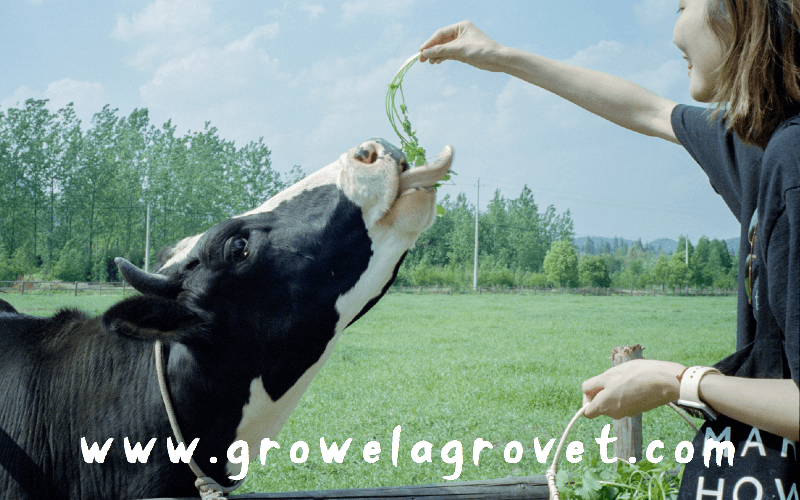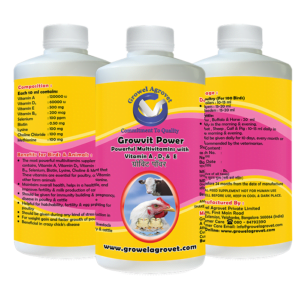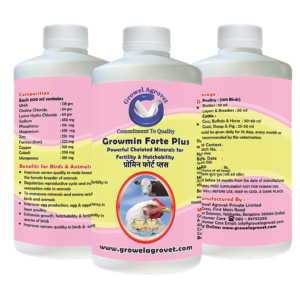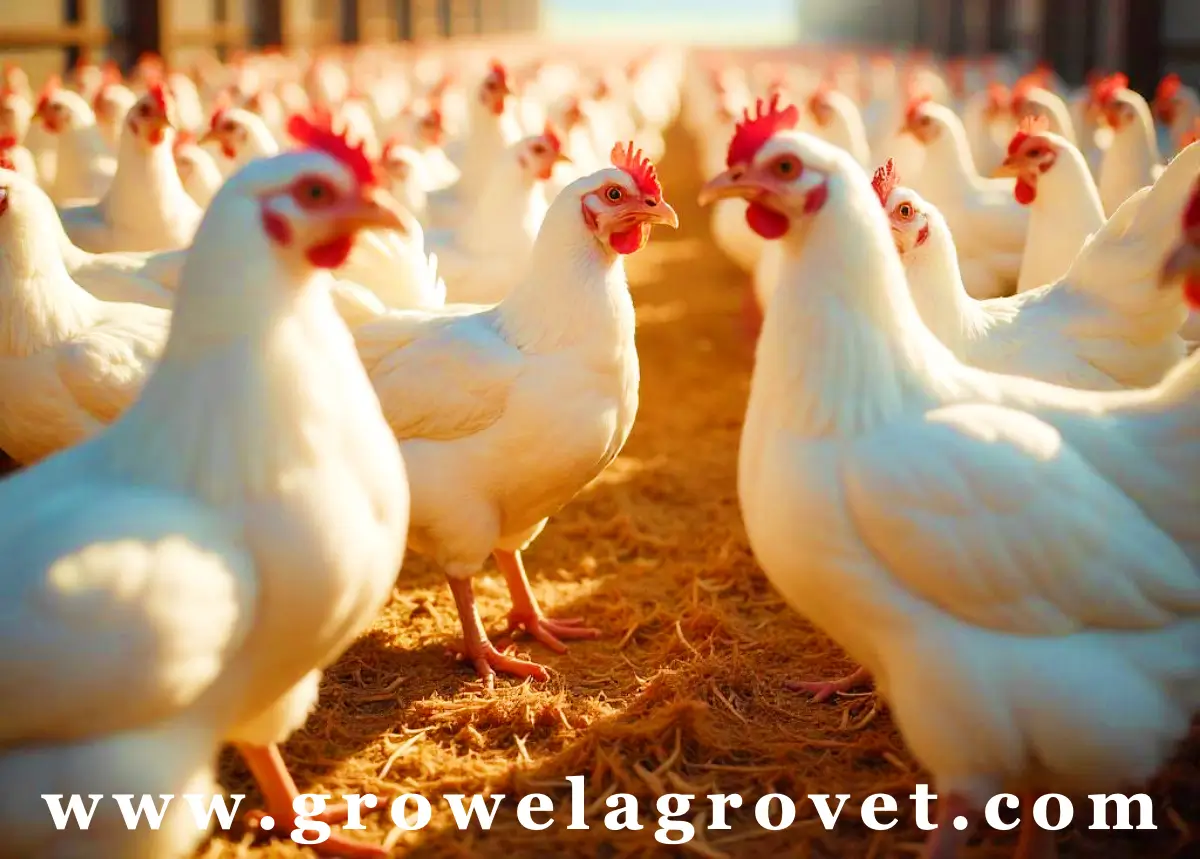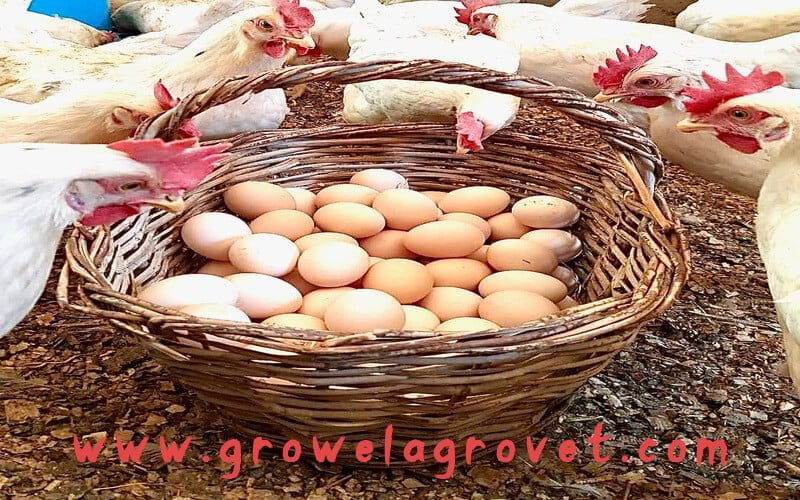Feeding the proper amounts of Vitamins and Minerals for Dairy Cattle is essential for the health, growth, and optimum milk production of dairy cattle. Feeding less than the optimum amount of any mineral or vitamin can result in an increased incidence of disease and reproductive problems, lower milk production, and decreased growth rate in heifers. To prevent these costly problems, the proper amounts of minerals and vitamins must be supplied and consumed by all dairy cattle, including milking cows, dry cows, and heifers.
To better understand how the feeding of vitamins and minerals is used, it is important to understand the digestion process in animals, first.
How Digestive Systems are Working in Dairy Cattle -The main distinction in a cow’s digestive system or a ruminant digestive system is that the stomach has four separate compartments, each with a unique function, whereas most other animals only have a single compartment with a unified functionality. In the mono-gastric or single stomached system, the digestive tract is essentially a muscular tube extending from the mouth to the anus. Its function is to ingest, grind, digest and absorb food, and to eliminate the waste products of the process.
The four compartments allow ruminant animals to digest grass or vegetation without completely chewing it first. Instead, they only partially chew the vegetation, then microorganisms in the rumen section of the stomach break down the rest. Animals with singular stomach compartments — known as a monogastric digestive system — do not have the same capability.
In the mono-gastric, food is taken into the mouth and mixed with saliva, which starts to break down the starch. The food then goes to the stomach where gastric juices break it down into its component nutrients. Further digestion occurs in the small intestine before nutrients are absorbed into the bloodstream and carried to every cell in the body. The watery mass remaining is propelled using the muscular movement of the digestive tract into the large intestine which has the important function of absorbing water from it. The large intestine terminates in the anus through which waste products are expelled as feces or manure.
Feeds for dairy cattle must supply energy, protein, certain vitamins, and minerals. Although different species have different nutritional requirements.
Important Vitamins and Minerals for Dairy Cattle:
Minerals for Dairy Cattle: The major minerals in cattle nutrition are calcium, phosphorus, sodium, chlorine, magnesium, and potassium. They are required at comparatively high levels described as a percent of diet or grams per day.
Essential vitamins and minerals for dairy cattle perform specific functions in the body and must be supplied in the diet, but too much of any may be harmful or even dangerous.
Calcium (Ca) and Phosphorus (P) for Dairy Cattle: Calcium (Ca) and Phosphorus (P) are the most abundant minerals present in the animal. They are also the ones most often added to ruminant diets. Both are found in the teeth and bones, but calcium is also found in milk and eggs. Also, Ca is necessary for the clotting of blood, the contraction of muscles, and the functioning of numerous biochemical reactions in the body. All biochemical reactions which allow the energy in food to be utilized by animals require phosphorus.
Animals usually require 1.5 parts of Ca for every part of P. Diets high in legume hay usually require supplemental P only, while diets high in grain often require supplemental Ca. Young animals, including humans, that do not receive adequate amounts of Ca or P may develop rickets, which in cattle show up as arched backs. A deficiency of vitamin D may also contribute to the problem. Older animals fed inadequate amounts of vitamin D develop osteomalacia, the symptoms of which are weak and easily fractured bones. Animals having diets low in Ca and P will show a drop in milk production. A low level of P in the diet may also cause poor reproductive performance in females and lower the availability of vitamin A.
For supplementing calcium, phosphorus, zinc & magnesium requirements you cattle owners should feed Grow Cal D3 , this is an excellent product for supplementing Calcium & Minerals requirements.
The main components of food are water and dry matter. The dry matter consists of organic material and inorganic material. Water is essential in the transport of metabolic products and wastes throughout the body and for most chemical reactions in the body. The amount of water required varies with the amount of feed consumed, body size, species, and the surrounding temperature. However, if water intake declines, feed intake usually declines. Water should be hygienic and clean, the water given to animals should be regularly sanitized through Aquacure, which will make the water hygienic & virus-free.
Requirements of Energy for Dairy Cattle:Animals require energy for maintenance, growth, work, and the production of milk and wool. Feeds are evaluated in terms of the amount of energy an animal can obtain from them. The digestible energy (DE) is the gross (total) amount of energy in the hay and grain fed an animal less the amount lost in the feces. Energy is usually reported in mega calories (Mcal) per kilogram. (One-kilo calorie is equal to 1,000 calories. One mega-calorie is equal to 1,000,000 calories).
The amount of digestible energy needed by an animal per day varies according to body size, weight gain, milk production, and work. The amount of energy required to maintain an animal for one day without loss of body weight is called the energy required for maintenance. Most symptoms of slight energy deficiency are not very noticeable. The more severe the energy deficiency, the more noticeable are the symptoms described. Excess energy is stored as fat.
The most common energy source is from the carbohydrates contained in feeds. These are the sugars, starches, cellulose, and hemicellulose which have been stored in plant tissues. Chemical reactions that take place in the animal release the energy in the feed (originally trapped from the sun by the plant) and convert it to other forms of energy that the animal can use.
Lipids are another energy source found in plants. They are fats and compounds closely related to them. They contain about two and a half times as much energy as carbohydrates.
Sodium and Chlorine for Dairy Cattle: Sodium and Chlorine are found together as sodium chloride (NaCl or common salt) and serve to maintain proper acidity levels in body fluid and pressure in body cells. The hydrochloric acid found in the stomach contains chlorine.
Even though many feeds contain enough sodium and chlorine to meet the requirements of cattle, supplemental cobalt iodized (blue) salt or trace mineral salt should be available at all times.
Potassium (K) for Dairy Cattle: Potassium (K) like sodium, serves to maintain proper acidity levels in body fluids and pressure in body cells. It is also required in several enzyme reactions in carbohydrate metabolism and protein synthesis. Forages normally contain more than adequate amounts of potassium. Supplemental potassium may be necessary for high-grain feedlot diets.
Magnesium (Mg) for Dairy Cattle: Magnesium (Mg) is necessary for the utilization of energy in the body and bone growth. Cattle fed on lush, immature pasture may have a low level of Mg in the blood, which can result in grass tetany, a disease characterized by convulsions, twitching of muscles, staggering gait, and falling.
Sulphur (S) for Dairy Cattle: Sulphur (S) is a component of body protein, some vitamins, and several hormones. It is involved in protein, fat, and carbohydrate metabolism as well as blood clotting and the maintenance of proper body fluid acidity. Most feeds contain adequate amounts of S for cattle. Supplemental S may be necessary when non-protein nitrogen sources are being utilized in high grain feedlot diets.
Trace Minerals for Dairy Cattle:Feeding trace minerals is not a simple matter. They are required only in very small amounts. Some minerals fed in excess amounts may cause a deficiency in others; a slight deficiency or excess may cause a decrease in performance that is hard to pinpoint. Even though the level in the diet appears adequate, an animal may occasionally respond to an increased supply of a particular mineral because other dietary factors may have decreased its availability.
Iron (Fe) for Dairy Cattle: Iron (Fe) is an essential part of hemoglobin, a compound that carries oxygen in the blood. A deficiency of iron may cause anemia and reduce growth. Generally, there is no need to supply extra iron except to baby pigs.
Zinc (Zn) for Dairy Cattle:Zinc (Zn) affects growth rate, skin conditions, reproduction, skeletal development, and the utilization of protein, carbohydrates, and fats in the body.
Zinc is an essential nutrient for animals, functioning largely or entirely in enzyme systems and being involved in protein synthesis, carbohydrate metabolism, and many other biochemical reactions. A severe zinc deficiency causes numerous pathological changes, including skin parakeratosis, reduced or cessation of growth, general debility, lethargy, and increased susceptibility to infection. However, the mechanism and routes by which specific enzymatic changes are responsible for the serious pathological alterations caused by the deficiency have not been elucidated. Recovery of calves from a severe zinc deficiency is rapid and dramatic.
Copper (Cu) for Dairy Cattle: A Copper (Cu) deficiency can result in anemia, depigmentation in hair, infertility, scouring, and cardiac failure. Feed testing laboratories find that many samples contain less than the estimated RDA of 10 ppm. Although the symptoms of copper deficiency are rarely evident, improved growth and performance are often seen after copper supplementation.
Manganese (Mn) for Dairy Cattle: Manganese (Mn) is essential for the utilization of carbohydrates. Manganese deficiency in cattle symptoms includes retarded bone growth and reproductive failure.
Cobalt (Co) for Dairy Cattle: Cobalt (Co) is necessary for the microorganisms in the rumen to synthesize vitamin B12.
Iodine (I) for Dairy Cattle: Dairy Cattle is needed in trace amounts by the thyroid gland, which influences the rate of metabolism in the body. A deficiency causes goiter. As the prairie provinces are deficient in both cobalt and iodine, a salt containing both of these elements must be used.
Molybdenum (Mo) for Dairy Cattle: Molybdenum (Mo) for Dairy Cattle forms an essential part of some enzymes. It may also have a stimulating effect on fiber-digesting microorganisms in the rumen.Excessive quantities of molybdenum interfere with the utilization of copper and may cause a copper deficiency, symptoms of which include severe scours and loss of body weight. If the diet is high in sulfur, the problem is more severe.
Selenium (Se) for Dairy Cattle: Selenium (Se) is deficient in some regions of the province and surplus in others. “Alkali disease” or “blind staggers” occurs when cattle eat feed containing toxic or excess amounts of Se (10 ppm) over a long period. Chronic toxicity results in loss of weight, dullness, sloughing of hooves, and lameness. Toxicity is rare but occasionally found where cattle on overgrazed pasture are forced to eat a milk-vetch that accumulates selenium. The best cure is to remove the animal from the pasture.
Selenium deficiency may result in “white muscle disease” in calves, lambs, and foals. A vitamin E deficiency increases the amount of selenium required to prevent this form of nutritional muscular dystrophy. Cows on Selenium deficient diets may have lower fertility and an increased incidence of retained placentas. Grow E- Sel should be added in feed to overcome Vitamin E-Selenium deficiency.
Chromium (Cr), tin (Sn), and nickel (NI) appear to be present in sufficient quantities to meet the requirements of most farm animals.
Fluorine (FI) for Dairy Cattle: Fluorine (FI) is essential for proper bone development but will cause toxicity if fed at too high a rate. It is used on domestic water supplies to reduce the incidence of tooth decay. Too much FI causes abnormal bone growth, mottling, and degeneration of teeth, and delayed growth and reproduction. To avoid excessive consumption of FI, be sure any rock phosphate fed is defluorinated.
Trace minerals can be effectively supplemented in the diets of cattle by using the proper trace mineralized salt.
Importance of Vitamins for Dairy Cattle :
These organic compounds are required in minute amounts by the body. They are essential to metabolism, and some must be supplied in the feed of ruminants.
Vitamin A is the most important vitamin in cattle nutrition. It is the only one that normally must be added to cattle diets. It is necessary for bone development, sight, and maintenance of healthy epithelial tissues (i.e. lining of digestive and reproductive tracts). A deficiency can cause increased susceptibility to disease, night blindness, and reproductive failure.
Vitamin A may be supplied by green forages that contain carotenoids. Carotenoids are broken down in the body to vitamin A. Thus forages are not analyzed for vitamin A but carotenoids, which are measured in milligrams per kilogram or pound: mg/kg or mg/Ib. Animals on green grass can store vitamin A in the liver and draw on it for 2-3 months.
To fulfill the requirement of Vitamin-A water-soluble vitamin A should be given to cattle. Grovit -A is a very good supplement to overcome the deficiency of Vitamin -A .
Vitamin D for Dairy Cattle: Vitamin D is called the sunshine vitamin because ultraviolet light acting on a compound on animal skin changes that compound into vitamin D. Vitamin D is found in sun-cured forages. Animals kept outdoors or fed sun-cured hay do not usually suffer a deficiency, whereas animals kept indoors and fed silage may do so. Supplementing Vitamin D is involved in the uptake of Calcium and Phosphorus so that a vitamin D deficiency resembles a Ca and P deficiency.
Vitamin E for Dairy Cattle: Vitamin E and selenium have similar and interrelated functions in the body. Vitamin E plays a vital role in the reproduction processes of dairy cattle. Vitamin E deficiency has been linked to embryonic death, testicular atrophy, and ovarian failure. The area of lactating cow supplementation with vitamin E that has received the most research attention is mastitis. Vitamin E is known to stimulate the immune system of cows. Mastitis is the clinical response of the mammary gland to a bacterial challenge. Therefore, vitamin E may enhance the mammary response to a bacterial challenge. Research has shown that cows with clinical mastitis have lower concentrations of vitamin E in their plasma and milk when compared to healthy herd mates. Vitamin E supplementation will enhance the activity of neutrophils, which are one of the types of cells in somatic cells. Vitamin E supplementation enhances immunoglobulin production.
We hope the ” Importance of Vitamins and Minerals for the Dairy Cattle” article would be very much helpful for your dairy cattle’s robust health. Feeding important vitamins & minerals for dairy cattle are very much important for robust cattle health, which leads to a profitable dairy farming business. You should also read How to Cut Cattle Feeding Costs.

